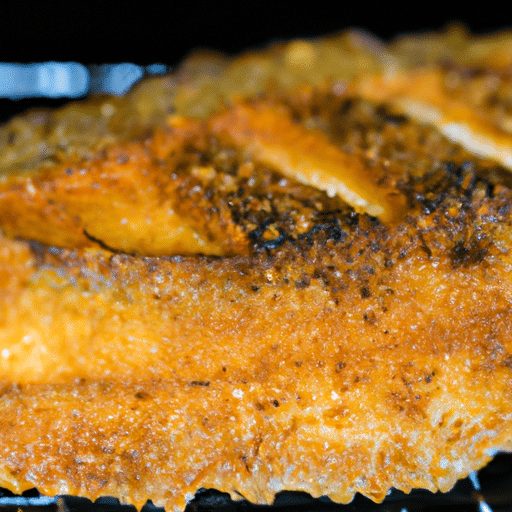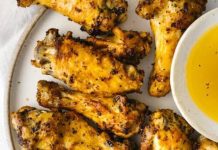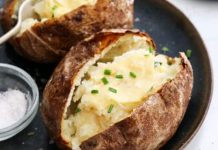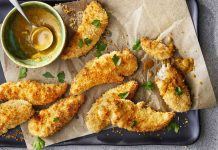We’ve all been there – trying to cook fish and seafood in the most delicious and convenient way possible. Well, look no further because we have the answer for you: an air fryer! Yes, you read that right. Gone are the days of deep frying and dealing with messy oil splatters. With an air fryer, you can achieve that crispy, golden brown exterior without the hassle. In this article, we will guide you through the step-by-step process of cooking fish and seafood in an air fryer, ensuring perfectly cooked, tender, and flavorful results every time. So get ready to elevate your seafood game to a whole new level with the help of this incredible kitchen appliance.
Choosing the Right Fish and Seafood
When it comes to cooking fish and seafood in an air fryer, one of the first considerations is choosing the right types that will work well with this cooking method. Freshness and quality are key factors that should be taken into account. Look for fish and seafood that is fresh and has a pleasant smell. The flesh should be firm and resilient, and the eyes of the fish should be clear and bright.
Certain types of fish and seafood tend to perform better in the air fryer due to their texture and moisture content. Fish fillets such as tilapia, salmon, cod, and halibut are great options as they cook evenly and retain their moisture. Shrimp and scallops are also perfect for air frying as they cook quickly and have a delicate texture. Experimenting with different types of fish and seafood can help you find your favorites and discover new flavors.
It’s important to consider how to cook frozen fish and seafood in an air fryer as well. While fresh fish is always a preferred choice, frozen options can be a convenient alternative. Look for individually frozen portions to ensure that the fish or seafood is of high quality and hasn’t been thawed and refrozen multiple times. Taking note of the recommended cooking times and temperatures for frozen fish and seafood is crucial to achieving the best results.
Preparing the Fish and Seafood
Before cooking fish and seafood in the air fryer, proper preparation is essential. If you’re dealing with frozen fish or seafood, it’s important to thaw them thoroughly. The safest way to thaw frozen fish is by placing it in the refrigerator overnight. This slow thawing process helps maintain the quality and texture of the fish.
For fresh fish, cleaning and gutting the fish is an important step in preparing it for the air fryer. Start by removing the scales using a fish scaler or a knife. Then, carefully gut the fish by making a small incision along the belly and removing the internal organs. Rinse the fish under cold water to remove any remaining blood or debris.
Removing the skin and bones is another step that can enhance the texture and taste of the fish. Use a sharp knife to carefully remove the skin, taking care not to remove too much flesh. To remove the bones, use tweezers or fishbone pliers to pull them out one by one. This step is optional but can make the eating experience more enjoyable, especially for those who prefer boneless fish.
Marinating the fish and seafood before cooking can add extra flavor and moisture. Consider using marinades or seasonings that complement the natural flavors of the fish. Lemon and herb marinades work well with delicate fish fillets, while Asian-inspired marinades with soy sauce and ginger can enhance the flavor of stronger fish varieties. Allow the fish to marinate for at least 30 minutes before cooking for optimal flavor.
Preheating and Preparing the Air Fryer
To ensure even cooking and optimal results, it’s important to preheat the air fryer before adding the fish or seafood. Follow the manufacturer’s instructions for preheating, as the process may vary depending on the model. Preheating generally takes around 3-5 minutes.
Choosing the right pan or basket is essential for air frying fish and seafood. Most air fryers come with a non-stick basket or tray designed specifically for cooking. If using a pan, choose one that fits comfortably in the air fryer, ensuring there is enough space for air circulation. The choice between a coated or uncoated pan depends on personal preference and the type of fish being cooked.
Applying cooking oil or spray is generally necessary when cooking fish and seafood in an air fryer. This step helps prevent sticking and promotes a crispy exterior. Use a cooking oil or spray that has a high smoke point, such as vegetable or canola oil. Apply a light coating of oil to the fish or seafood before placing it in the air fryer.
Basic Techniques for Cooking Fish and Seafood
Once the fish and seafood are prepared and the air fryer is preheated, it’s time to start cooking. The technique will vary depending on the type of fish and seafood being cooked.
For whole fish, it’s important to ensure that it fits comfortably in the air fryer basket or pan. Season the fish with salt, pepper, and any desired herbs or spices. Place the fish in the air fryer, allowing enough space for air circulation. Cook at the recommended temperature for the specified cooking time, flipping halfway through for even cooking.
Fish fillets can be cooked in the air fryer by placing them directly in the basket or on the pan. Season the fillets with salt, pepper, and any desired seasonings. Cook at the recommended temperature for the specified cooking time, flipping halfway through if necessary.
Shellfish such as shrimp and scallops can be cooked in the air fryer by placing them directly in the basket or on the pan. Season with salt, pepper, and any desired spices or herbs. Cook at the recommended temperature for the specified cooking time, shaking or flipping halfway through for even cooking.
Fish cakes and patties can also be cooked in the air fryer. Place them in the basket or on the pan, leaving some space between each patty. Cook at the recommended temperature for the specified cooking time, flipping halfway through if necessary.
Seafood skewers are a delicious and convenient option for air frying. Thread shrimp, scallops, or cubes of fish onto skewers and season with salt, pepper, and any desired marinades or herbs. Place the skewers in the air fryer, making sure they are not touching the heating element. Cook at the recommended temperature for the specified cooking time, flipping or rotating the skewers for even cooking.
Recommended Cooking Times and Temperatures
To achieve perfectly cooked fish and seafood, it’s important to determine the appropriate cooking time and temperature for each type. The cooking time may vary depending on the thickness and size of the fish or seafood, as well as personal preference for doneness.
When determining the cooking time, it’s helpful to refer to recommended guidelines or recipes specific to the air fryer. These guidelines usually provide a range of cooking times and temperatures for different types of fish and seafood. It’s important to note that these are general recommendations and may need to be adjusted based on the specific air fryer model and personal preference for doneness.
When cooking fish fillets, a temperature of 400°F (200°C) is commonly recommended. The cooking time may range from 8 to 15 minutes, depending on the thickness of the fillets. Thicker fillets may require a longer cooking time, while thinner fillets may cook more quickly.
For whole fish, a temperature of 375°F (190°C) is generally recommended. The cooking time can range from 12 to 20 minutes, depending on the size of the fish. Larger fish will require a longer cooking time to ensure that the flesh is cooked through.
Shellfish such as shrimp and scallops are quick-cooking and usually require a higher temperature of 400°F (200°C). The cooking time can range from 5 to 10 minutes, depending on the size and thickness of the shellfish. Keep a close eye on shellfish as they cook quickly and can become overcooked.
When cooking fish cakes and patties, a temperature of 375°F (190°C) is typically recommended. The cooking time may range from 10 to 15 minutes, depending on the size and thickness of the patties. Flip the patties halfway through the cooking time to ensure even browning.
Seafood skewers should be cooked at a temperature of 400°F (200°C). The cooking time can range from 8 to 12 minutes, depending on the size and thickness of the seafood. Flip or rotate the skewers halfway through the cooking time to ensure they cook evenly.
Avoiding Common Cooking Mistakes
While cooking fish and seafood in an air fryer is generally straightforward, there are a few common mistakes to avoid in order to achieve the best results.
Overcooking fish and seafood is a common pitfall. The high heat of the air fryer can quickly dry out the fish and seafood if left in for too long. Keep a close eye on the cooking time and check the doneness of the fish or seafood regularly. Remove it from the air fryer as soon as it reaches the desired level of doneness to prevent dryness.
On the other hand, undercooking fish and seafood can result in an unpleasant eating experience. Ensure that the fish and seafood reach the appropriate internal temperature for safety and doneness. Invest in a reliable instant-read thermometer to accurately gauge the temperature.
Using too much or too little oil can also impact the outcome of the dish. Too much oil may cause the fish or seafood to become greasy, while too little oil may result in sticking and a less crispy texture. Apply a light coating of oil to the fish or seafood before cooking, ensuring an even distribution.
Not seasoning properly can lead to bland-tasting fish and seafood. Take the time to season the fish or seafood with salt, pepper, and any desired herbs or spices. This step helps enhance the natural flavors and adds depth to the dish.
Choosing the wrong fish or seafood for air frying can also affect the outcome. Certain fish and seafood varieties with a high oil content or delicate flesh may not fare well in the air fryer. Make sure to choose fish and seafood that is suitable for this cooking method.
Tips for Achieving Optimal Results
To achieve the best results when cooking fish and seafood in an air fryer, consider incorporating these helpful tips:
Using parchment paper or aluminum foil can make cleaning up a breeze. Place a sheet of parchment paper or aluminum foil in the bottom of the air fryer basket or pan before adding the fish or seafood. This helps prevent sticking and makes it easier to remove any residue.
Flipping or shaking the fish or seafood during cooking can help ensure even cooking and browning. For fillets, gently flip them halfway through the cooking time. For whole fish or shellfish, shake the basket or gently turn them to promote even browning.
Adding basting sauces or glazes can add an extra layer of flavor to the fish or seafood. Consider brushing the fish or seafood with a marinade or glaze during the cooking process. This technique enhances the taste and provides a beautiful glaze.
Using breadcrumbs or coating the fish or seafood can provide a crispy texture. Dip the fish or seafood in beaten egg or buttermilk, then coat with breadcrumbs or a mixture of breadcrumbs and flour. This technique adds a delightful crunch to the dish.
Garnishing and serving suggestions can elevate the presentation of the fish or seafood. Consider adding fresh herbs, lemon wedges, or a drizzle of sauce to enhance the visual appeal. Serve the cooked fish or seafood with a side dish of your choice, such as roasted vegetables or a refreshing salad.
Cleaning and Maintenance of Air Fryer
Proper cleaning and maintenance of the air fryer are essential for its longevity and optimal performance. Follow these guidelines to keep your air fryer in top shape:
Proper cleaning procedures should be followed after each use. Allow the air fryer to cool down completely before cleaning. Remove the basket or pan and wash it with warm soapy water. Use a non-abrasive sponge or cloth to clean the interior and exterior of the air fryer. Rinse thoroughly and dry before storing.
Removing grease and residual remnants is important to prevent build-up and maintain the air fryer’s function. Use a soft-bristle brush or a non-abrasive sponge to remove any stuck-on food particles or grease. Avoid using harsh chemicals or abrasive cleaners that may damage the non-stick surface.
Regular maintenance is key to keeping the air fryer in optimal condition. Check the heating element and fan regularly for any signs of damage or debris. Clean these components as needed using a soft cloth or brush. Refer to the manufacturer’s instructions for any specific maintenance requirements.
Modification and Experimentation
One of the joys of cooking fish and seafood in an air fryer is the ability to modify and experiment with flavors and ingredients. Here are some ideas for adding your personal touch to your air-fried creations:
Adding personal flavors and ingredients to marinades can give a unique twist to your fish and seafood dishes. Try incorporating different herbs, spices, or even citrus fruits into your marinades for a burst of flavor. Experiment with different combinations to create your signature marinade.
Trying different coatings and crumbs can provide exciting textures to your fish and seafood. Instead of traditional breadcrumbs, consider using crushed nuts, panko breadcrumbs, or even crushed potato chips to coat your fish or seafood. The possibilities are endless.
Combining fish and seafood varieties can create interesting flavor profiles. Mix different types of fish or seafood in one dish to create a medley of flavors and textures. For example, combine shrimp and cod in a seafood stir-fry or pair salmon with scallops for a delightful surf and turf experience.
Pairing with dips, sauces, and side dishes can elevate the overall dining experience. Serve your air-fried fish or seafood with a delicious dipping sauce such as tartar sauce, aioli, or a tangy lemon butter sauce. Consider pairing it with sides like rice pilaf, steamed vegetables, or a fresh salad to complete the meal.
Chef’s Recommendations and Expert Tips
For further guidance and expert tips on cooking fish and seafood in an air fryer, here are some recommendations from professional chefs:
Professional insights on cooking fish and seafood are always valuable. Chefs recommend using a meat thermometer to ensure accurate cooking temperatures. This helps prevent overcooking or undercooking the fish or seafood.
Alternative cooking techniques and appliances can provide versatile options for cooking fish and seafood. Chefs suggest trying other cooking methods like grilling, baking, or pan-searing to expand your culinary repertoire. Each method brings out unique flavors and textures in the fish and seafood.
Specific varieties and cuts to explore can help broaden your culinary knowledge. Chefs recommend trying different fish species and cuts to discover new flavors and textures. From meaty tuna steaks to delicate sole fillets, each variety offers its own unique characteristics that can be enjoyed in various recipes.
In conclusion, cooking fish and seafood in an air fryer can open up a world of delicious possibilities. By choosing the right fish and seafood, preparing them properly, and utilizing the correct cooking techniques and temperatures, you can achieve perfectly cooked and flavorful dishes every time. Avoiding common cooking mistakes, incorporating helpful tips, and experimenting with different flavors and ingredients will allow you to create personalized and exciting dishes. With proper cleaning and maintenance, your air fryer will continue to be a reliable cooking companion. So go ahead, dive into the world of air-fried fish and seafood, and let your taste buds embark on an unforgettable culinary adventure.





































